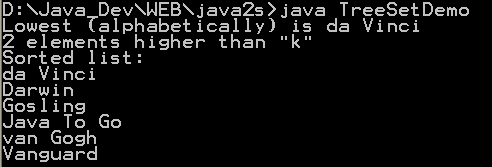This program uses a set to print all unique words in System.in : Set « Collections Data Structure « Java
- Java
- Collections Data Structure
- Set
This program uses a set to print all unique words in System.in
/*
This program is a part of the companion code for Core Java 8th ed.
(http://horstmann.com/corejava)
This program is free software: you can redistribute it and/or modify
it under the terms of the GNU General Public License as published by
the Free Software Foundation, either version 3 of the License, or
(at your option) any later version.
This program is distributed in the hope that it will be useful,
but WITHOUT ANY WARRANTY; without even the implied warranty of
MERCHANTABILITY or FITNESS FOR A PARTICULAR PURPOSE. See the
GNU General Public License for more details.
You should have received a copy of the GNU General Public License
along with this program. If not, see <http://www.gnu.org/licenses/>.
*/
import java.util.HashSet;
import java.util.Iterator;
import java.util.Scanner;
import java.util.Set;
/**
* This program uses a set to print all unique words in System.in.
* @version 1.10 2003-08-02
* @author Cay Horstmann
*/
public class SetTest
{
public static void main(String[] args)
{
Set<String> words = new HashSet<String>(); // HashSet implements Set
long totalTime = 0;
Scanner in = new Scanner(System.in);
while (in.hasNext())
{
String word = in.next();
long callTime = System.currentTimeMillis();
words.add(word);
callTime = System.currentTimeMillis() - callTime;
totalTime += callTime;
}
Iterator<String> iter = words.iterator();
for (int i = 1; i <= 20 && iter.hasNext(); i++)
System.out.println(iter.next());
System.out.println(". . .");
System.out.println(words.size() + " distinct words. " + totalTime + " milliseconds.");
}
}
Related examples in the same category
| 1. | Set, HashSet and TreeSet | | |
| 2. | Things you can do with Sets | |  |
| 3. | Set operations: union, intersection, difference, symmetric difference, is subset, is superset | | |
| 4. | Set implementation that use == instead of equals() | | |
| 5. | Set that compares object by identity rather than equality | | |
| 6. | Set union and intersection | | |
| 7. | Set with values iterated in insertion order. | | |
| 8. | Putting your own type in a Set | |  |
| 9. | Use set | |  |
| 10. | Another Set demo | | |
| 11. | Set subtraction | |  |
| 12. | Working with HashSet and TreeSet | |  |
| 13. | TreeSet Demo | |  |
| 14. | Show the union and intersection of two sets | | |
| 15. | Demonstrate the Set interface | | |
| 16. | Array Set extends AbstractSet | |  |
| 17. | Sync Test | | |
| 18. | Set Copy | | |
| 19. | Set and TreeSet | | |
| 20. | Tail | | |
| 21. | What you can do with a TreeSet | |  |
| 22. | Remove all elements from a set | | |
| 23. | Copy all the elements from set2 to set1 (set1 += set2), set1 becomes the union of set1 and set2 | | |
| 24. | Remove all the elements in set1 from set2 (set1 -= set2), set1 becomes the asymmetric difference of set1 and set2 | | |
| 25. | Get the intersection of set1 and set2, set1 becomes the intersection of set1 and set2 | | |
| 26. | Extend AbstractSet to Create Simple Set | | |
| 27. | Int Set | | |
| 28. | One Item Set | | |
| 29. | Small sets whose elements are known to be unique by construction | | |
| 30. | List Set implements Set | | |
| 31. | Converts a char array to a Set | | |
| 32. | Converts a string to a Set | | |
| 33. | Implements the Set interface, backed by a ConcurrentHashMap instance | | |
| 34. | An IdentitySet that uses reference-equality instead of object-equality | | |
| 35. | An implementation of the java.util.Stack based on an ArrayList instead of a Vector, so it is not synchronized to protect against multi-threaded access. | | |
| 36. | A thin wrapper around a List transforming it into a modifiable Set. | | |
| 37. | A thread-safe Set that manages canonical objects | | |
| 38. | Indexed Set | | |
| 39. | An ObjectToSet provides a java.util.Map from arbitrary objects to objects of class java.util.Set. | | |
| 40. | Sorted Multi Set | | |
| 41. | Fixed Size Sorted Set | | |
| 42. | Set operations | | |
| 43. | A NumberedSet is a generic container of Objects where each element is identified by an integer id. | | |
| 44. | Set which counts the number of times a values are added to it. | | |
| 45. | Set which counts the number of times a values are added to it and assigns them a unique positive index. | | |
| 46. | Indexed Set | | |
| 47. | A set acts like array. | | |
| 48. | Implements a Bloom filter. Which, as you may not know, is a space-efficient structure for storing a set. | | |
| 49. | Implementation of disjoint-set data structure | | |
| 50. | Call it an unordered list or a multiset, this collection is defined by oxymorons | | |